technical data SKODA ROOMSTER 2009 1.G Repair Manual
[x] Cancel search | Manufacturer: SKODA, Model Year: 2009, Model line: ROOMSTER, Model: SKODA ROOMSTER 2009 1.GPages: 263, PDF Size: 32.25 MB
Page 122 of 263
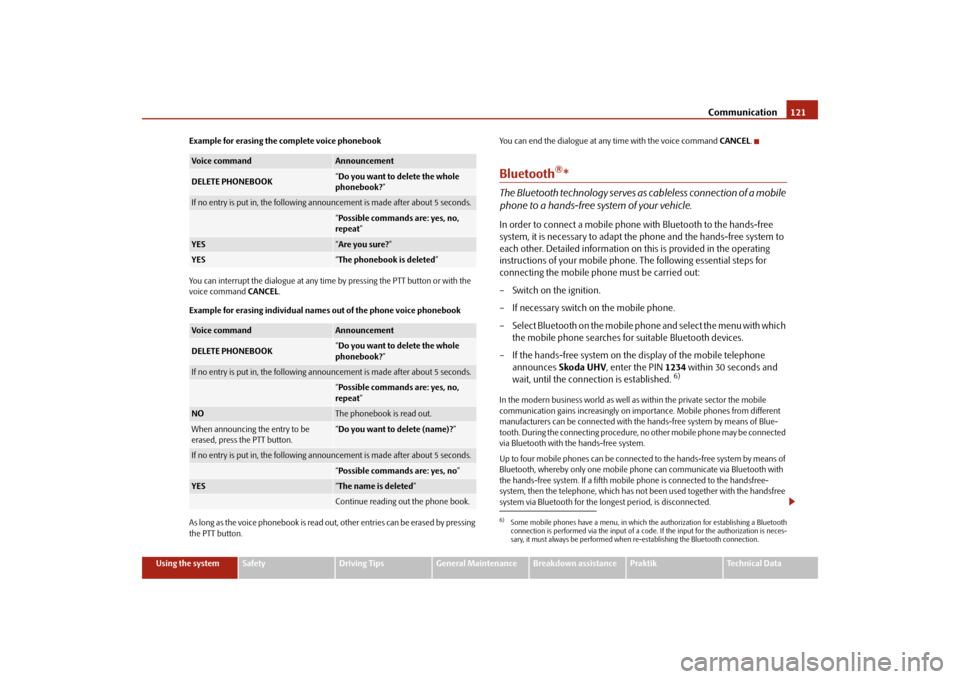
Communication121
Using the system
Safety
Driving Tips
General Maintenance
Breakdown assistance
Praktik
Technical Data Example for erasing the complete voice phonebook
You can interrupt the dialogue at any time by pressing the PTT button or with the
voice command CANCEL.
Example for erasing individual names out of the phone voice phonebook
As long as the voice phonebook is read out, other entries can be erased by pressing
the PTT button.You can end the dialogue at any time with the voice command CANCEL.
Bluetooth
®*
The Bluetooth technology serves as cableless connection of a mobile
phone to a hands-free system of your vehicle.In order to connect a mobile phone with Bluetooth to the hands-free
system, it is necessary to adapt the phone and the hands-free system to
each other. Detailed information on this is provided in the operating
instructions of your mobile phone. The following essential steps for
connecting the mobile phone must be carried out:
– Switch on the ignition.
– If necessary switch on the mobile phone.
– Select Bluetooth on the mobile phone and select the menu with which
the mobile phone searches for suitable Bluetooth devices.
– If the hands-free system on the display of the mobile telephone
announces Skoda UHV, enter the PIN 1234 within 30 seconds and
wait, until the connection is established.
6)
In the modern business world as well as within the private sector the mobile
communication gains increasingly on importance. Mobile phones from different
manufacturers can be connected with the hands-free system by means of Blue-
tooth. During the connecting procedure, no other mobile phone may be connected
via Bluetooth with the hands-free system.
Up to four mobile phones can be connected to the hands-free system by means of
Bluetooth, whereby only one mobile phone can communicate via Bluetooth with
the hands-free system. If a fifth mobile phone is connected to the handsfree-
system, then the telephone, which has not been used together with the handsfree
system via Bluetooth for the longest period, is disconnected.
Voice command
Announcement
DELETE PHONEBOOK
“Do you want to delete the whole
phonebook?”
If no entry is put in, the following announcement is made after about 5 seconds.
“Possible commands are: yes, no,
repeat”
YES
“Are you sure?”
YES
“The phonebook is deleted”
Voice command
Announcement
DELETE PHONEBOOK
“Do you want to delete the whole
phonebook?”
If no entry is put in, the following announcement is made after about 5 seconds.
“Possible commands are: yes, no,
repeat”
NO
The phonebook is read out.
When announcing the entry to be
erased, press the PTT button.
“Do you want to delete (name)?”
If no entry is put in, the following announcement is made after about 5 seconds.
“Possible commands are: yes, no”
YES
“The name is deleted”Continue reading out the phone book.
6)Some mobile phones have a menu, in which the authorization for establishing a Bluetooth
connection is performed via the input of a code. If the input for the authorization is neces-
sary, it must always be performed when re-establishing the Bluetooth connection.
s29g.4.book Page 121 Wednesday, June 17, 2009 9:54 AM
Page 123 of 263
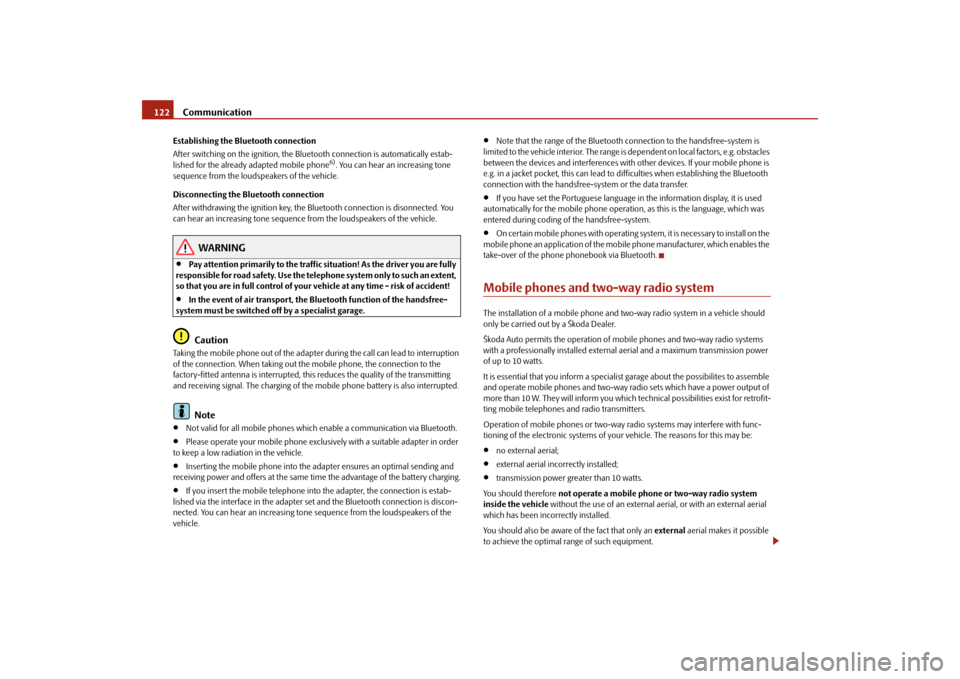
Communication 122Establishing the Bluetooth connection
After switching on the ignition, the Bluetooth connection is automatically estab-
lished for the already adapted mobile phone
6). You can hear an increasing tone
sequence from the loudspeakers of the vehicle.
Disconnecting the Bluetooth connection
After withdrawing the ignition key, the Bluetooth connection is disonnected. You
can hear an increasing tone sequence from the loudspeakers of the vehicle.
WARNING
•
Pay attention primarily to the traffic situation! As the driver you are fully
responsible for road safety. Use the telephone system only to such an extent,
so that you are in full control of your vehicle at any time - risk of accident!
•
In the event of air transport, the Bluetooth function of the handsfree-
system must be switched off by a specialist garage.Caution
Taking the mobile phone out of the adapter during the call can lead to interruption
of the connection. When taking out the mobile phone, the connection to the
factory-fitted antenna is interrupted, this reduces the quality of the transmitting
and receiving signal. The charging of the mobile phone battery is also interrupted.
Note
•
Not valid for all mobile phones which enable a communication via Bluetooth.
•
Please operate your mobile phone exclusively with a suitable adapter in order
to keep a low radiation in the vehicle.
•
Inserting the mobile phone into the adapter ensures an optimal sending and
receiving power and offers at the same time the advantage of the battery charging.
•
If you insert the mobile telephone into the adapter, the connection is estab-
lished via the interface in the adapter set and the Bluetooth connection is discon-
nected. You can hear an increasing tone sequence from the loudspeakers of the
vehicle.
•
Note that the range of the Bluetooth connection to the handsfree-system is
limited to the vehicle interior. The range is dependent on local factors, e.g. obstacles
between the devices and interferences with other devices. If your mobile phone is
e.g. in a jacket pocket, this can lead to difficulties when establishing the Bluetooth
connection with the handsfree-system or the data transfer.
•
If you have set the Portuguese language in the information display, it is used
automatically for the mobile phone operation, as this is the language, which was
entered during coding of the handsfree-system.
•
On certain mobile phones with operating system, it is necessary to install on the
mobile phone an application of the mobile phone manufacturer, which enables the
take-over of the phone phonebook via Bluetooth.
Mobile phones and two-way radio systemThe installation of a mobile phone and two-way radio system in a vehicle should
only be carried out by a Škoda Dealer.
Škoda Auto permits the operation of mobile phones and two-way radio systems
with a professionally installed external aerial and a maximum transmission power
of up to 10 watts.
It is essential that you inform a specialist garage about the possibilites to assemble
and operate mobile phones and two-way radio sets which have a power output of
more than 10 W. They will inform you which technical possibilities exist for retrofit-
ting mobile telephones and radio transmitters.
Operation of mobile phones or two-way radio systems may interfere with func-
tioning of the electronic systems of your vehicle. The reasons for this may be:•
no external aerial;
•
external aerial incorrectly installed;
•
transmission power greater than 10 watts.
You should therefore not operate a mobile phone or two-way radio system
inside the vehicle without the use of an external aerial, or with an external aerial
which has been incorrectly installed.
You should also be aware of the fact that only an external aerial makes it possible
to achieve the optimal range of such equipment.
s29g.4.book Page 122 Wednesday, June 17, 2009 9:54 AM
Page 124 of 263
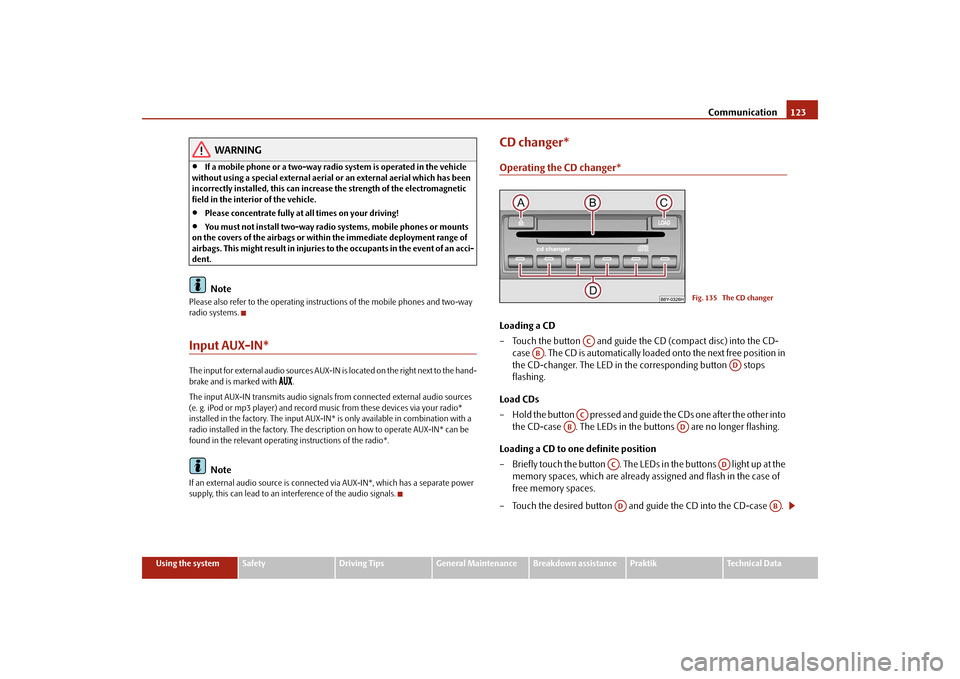
Communication123
Using the system
Safety
Driving Tips
General Maintenance
Breakdown assistance
Praktik
Technical Data
WARNING
•
If a mobile phone or a two-way radio system is operated in the vehicle
without using a special external aerial or an external aerial which has been
incorrectly installed, this can increase the strength of the electromagnetic
field in the interior of the vehicle.
•
Please concentrate fully at all times on your driving!
•
You must not install two-way radio systems, mobile phones or mounts
on the covers of the airbags or within the immediate deployment range of
airbags. This might result in injuries to the occupants in the event of an acci-
dent.Note
Please also refer to the operating instructions of the mobile phones and two-way
radio systems.Input AUX-IN*The input for external audio sources AUX-IN is located on the right next to the hand-
brake and is marked with
.
The input AUX-IN transmits audio signals from connected external audio sources
(e. g. iPod or mp3 player) and record music from these devices via your radio*
installed in the factory. The input AUX-IN* is only available in combination with a
radio installed in the factory. The description on how to operate AUX-IN* can be
found in the relevant operating instructions of the radio*.
Note
If an external audio source is connected via AUX-IN*, which has a separate power
supply, this can lead to an interference of the audio signals.
CD changer*Operating the CD changer*Loading a CD
– Touch the button and guide the CD (compact disc) into the CD-
case . The CD is automatically loaded onto the next free position in
the CD-changer. The LED in the corresponding button stops
flashing.
Load CDs
– Hold the button pressed and guide the CDs one after the other into
the CD-case . The LEDs in the buttons are no longer flashing.
Loading a CD to one definite position
– Briefly touch the button . The LEDs in the buttons light up at the
memory spaces, which are already assigned and flash in the case of
free memory spaces.
– Touch the desired button and guide the CD into the CD-case .
Fig. 135 The CD changer
AC
AB
AD
AC
AB
AD
AC
AD
AD
AB
s29g.4.book Page 123 Wednesday, June 17, 2009 9:54 AM
Page 126 of 263
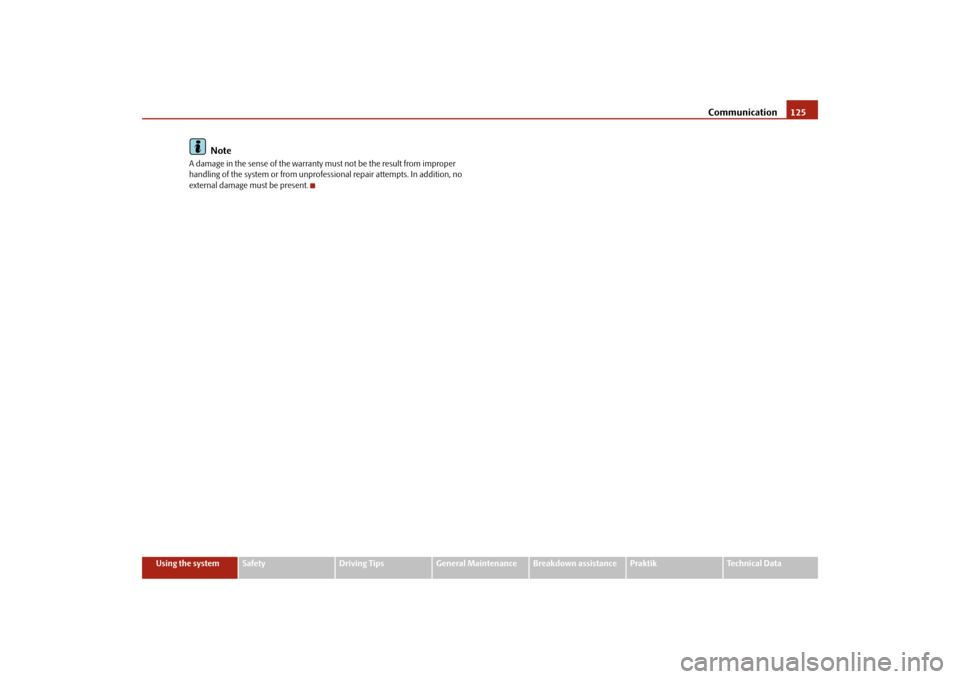
Communication125
Using the system
Safety
Driving Tips
General Maintenance
Breakdown assistance
Praktik
Technical Data
Note
A damage in the sense of the warranty must not be the result from improper
handling of the system or from unprofessional repair attempts. In addition, no
external damage must be present.
s29g.4.book Page 125 Wednesday, June 17, 2009 9:54 AM
Page 128 of 263
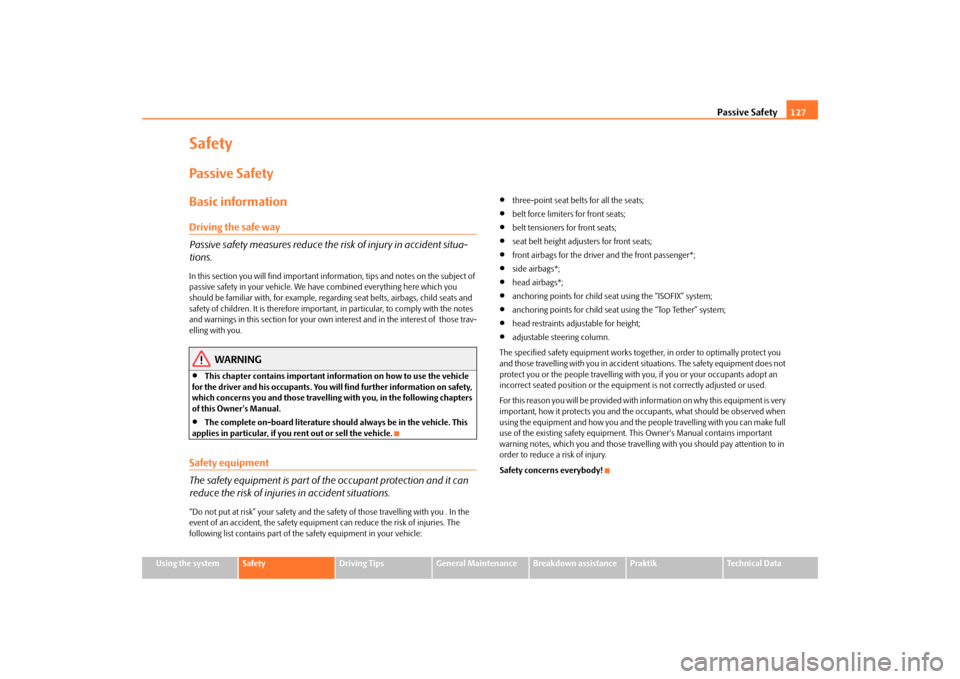
Passive Safety127
Using the system
Safety
Driving Tips
General Maintenance
Breakdown assistance
Praktik
Technical Data
SafetyPassive SafetyBasic informationDriving the safe way
Passive safety measures reduce the risk of injury in accident situa-
tions.In this section you will find important information, tips and notes on the subject of
passive safety in your vehicle. We have combined everything here which you
should be familiar with, for example, regarding seat belts, airbags, child seats and
safety of children. It is therefore important, in particular, to comply with the notes
and warnings in this section for your own interest and in the interest of those trav-
elling with you.
WARNING
•
This chapter contains important information on how to use the vehicle
for the driver and his occupants. You will find further information on safety,
which concerns you and those travelling with you, in the following chapters
of this Owner's Manual.
•
The complete on-board literature should always be in the vehicle. This
applies in particular, if you rent out or sell the vehicle.
Safety equipment
The safety equipment is part of the occupant protection and it can
reduce the risk of injuries in accident situations.“Do not put at risk” your safety and the safety of those travelling with you . In the
event of an accident, the safety equipment can reduce the risk of injuries. The
following list contains part of the safety equipment in your vehicle:
•
three-point seat belts for all the seats;
•
belt force limiters for front seats;
•
belt tensioners for front seats;
•
seat belt height adjusters for front seats;
•
front airbags for the driver and the front passenger*;
•
side airbags*;
•
head airbags*;
•
anchoring points for child seat using the “ISOFIX” system;
•
anchoring points for child seat using the “Top Tether” system;
•
head restraints adjustable for height;
•
adjustable steering column.
The specified safety equipment works together, in order to optimally protect you
and those travelling with you in accident situations. The safety equipment does not
protect you or the people travelling with you, if you or your occupants adopt an
incorrect seated position or the equipment is not correctly adjusted or used.
Fo r t h i s re a s o n y o u w i l l b e p ro v i d e d w i th i n fo rm a ti o n o n w hy t h i s e q u i p m e nt i s v e r y
important, how it protects you and the occupants, what should be observed when
using the equipment and how you and the people travelling with you can make full
use of the existing safety equipment. This Owner's Manual contains important
warning notes, which you and those travelling with you should pay attention to in
order to reduce a risk of injury.
Safety concerns everybody!
s29g.4.book Page 127 Wednesday, June 17, 2009 9:54 AM
Page 130 of 263
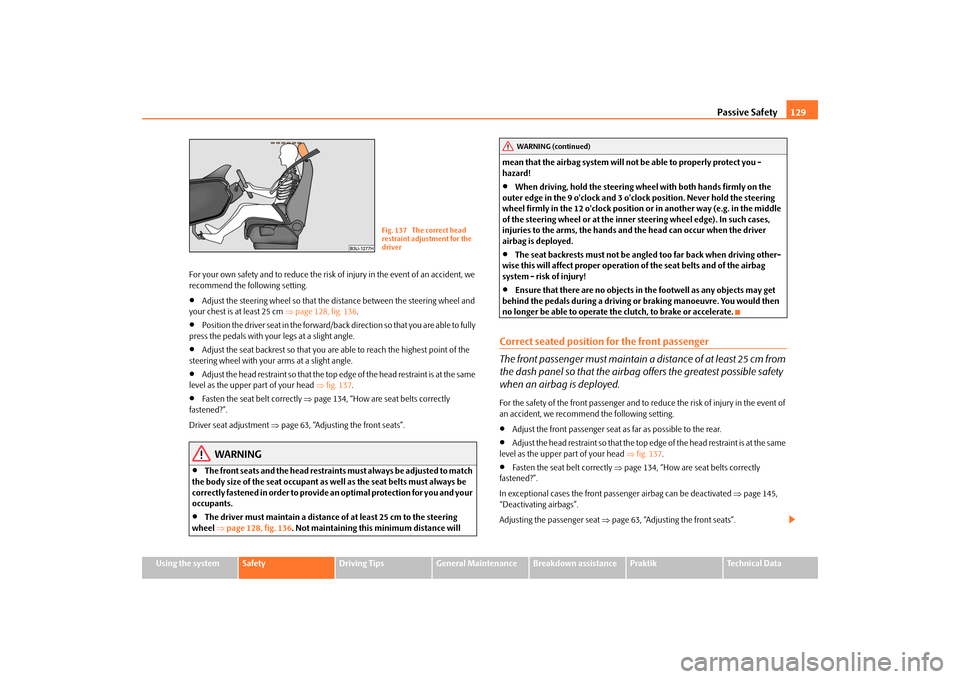
Passive Safety129
Using the system
Safety
Driving Tips
General Maintenance
Breakdown assistance
Praktik
Technical Data For your own safety and to reduce the risk of injury in the event of an accident, we
recommend the following setting.
•
Adjust the steering wheel so that the distance between the steering wheel and
your chest is at least 25 cm ⇒page 128, fig. 136.
•
Position the driver seat in the forward/back direction so that you are able to fully
press the pedals with your legs at a slight angle.
•
Adjust the seat backrest so that you are able to reach the highest point of the
steering wheel with your arms at a slight angle.
•
Adjust the head restraint so that the top edge of the head restraint is at the same
level as the upper part of your head ⇒fig. 137.
•
Fasten the seat belt correctly ⇒page 134, “How are seat belts correctly
fastened?”.
Driver seat adjustment ⇒page 63, “Adjusting the front seats”.
WARNING
•
The front seats and the head restraints must always be adjusted to match
the body size of the seat occupant as well as the seat belts must always be
correctly fastened in order to provide an optimal protection for you and your
occupants.
•
The driver must maintain a distance of at least 25 cm to the steering
wheel ⇒page 128, fig. 136. Not maintaining this minimum distance will mean that the airbag system will not be able to properly protect you -
hazard!
•
When driving, hold the steering wheel with both hands firmly on the
outer edge in the 9 o'clock and 3 o'clock position. Never hold the steering
wheel firmly in the 12 o'clock position or in another way (e.g. in the middle
of the steering wheel or at the inner steering wheel edge). In such cases,
injuries to the arms, the hands and the head can occur when the driver
airbag is deployed.
•
The seat backrests must not be angled too far back when driving other-
wise this will affect proper operation of the seat belts and of the airbag
system - risk of injury!
•
Ensure that there are no objects in the footwell as any objects may get
behind the pedals during a driving or braking manoeuvre. You would then
no longer be able to operate the clutch, to brake or accelerate.
Correct seated position for the front passenger
The front passenger must maintain a distance of at least 25 cm from
the dash panel so that the airbag offers the greatest possible safety
when an airbag is deployed.For the safety of the front passenger and to reduce the risk of injury in the event of
an accident, we recommend the following setting.•
Adjust the front passenger seat as far as possible to the rear.
•
Adjust the head restraint so that the top edge of the head restraint is at the same
level as the upper part of your head ⇒fig. 137.
•
Fasten the seat belt correctly ⇒page 134, “How are seat belts correctly
fastened?”.
In exceptional cases the front passenger airbag can be deactivated ⇒page 145,
“Deactivating airbags”.
Adjusting the passenger seat ⇒page 63, “Adjusting the front seats”.
Fig. 137 The correct head
restraint adjustment for the
driver
WARNING (continued)
s29g.4.book Page 129 Wednesday, June 17, 2009 9:54 AM
Page 132 of 263
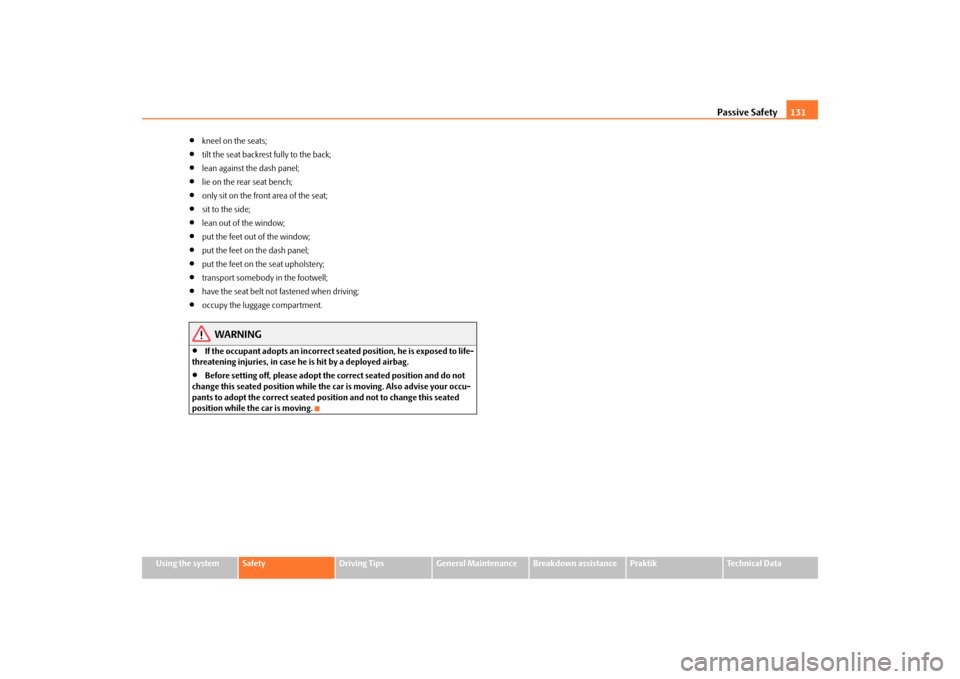
Passive Safety131
Using the system
Safety
Driving Tips
General Maintenance
Breakdown assistance
Praktik
Technical Data
•
kneel on the seats;
•
tilt the seat backrest fully to the back;
•
lean against the dash panel;
•
lie on the rear seat bench;
•
only sit on the front area of the seat;
•
sit to the side;
•
lean out of the window;
•
put the feet out of the window;
•
put the feet on the dash panel;
•
put the feet on the seat upholstery;
•
transport somebody in the footwell;
•
have the seat belt not fastened when driving;
•
occupy the luggage compartment.
WARNING
•
If the occupant adopts an incorrect seated position, he is exposed to life-
threatening injuries, in case he is hit by a deployed airbag.
•
Before setting off, please adopt the correct seated position and do not
change this seated position while the car is moving. Also advise your occu-
pants to adopt the correct seated position and not to change this seated
position while the car is moving.
s29g.4.book Page 131 Wednesday, June 17, 2009 9:54 AM
Page 134 of 263
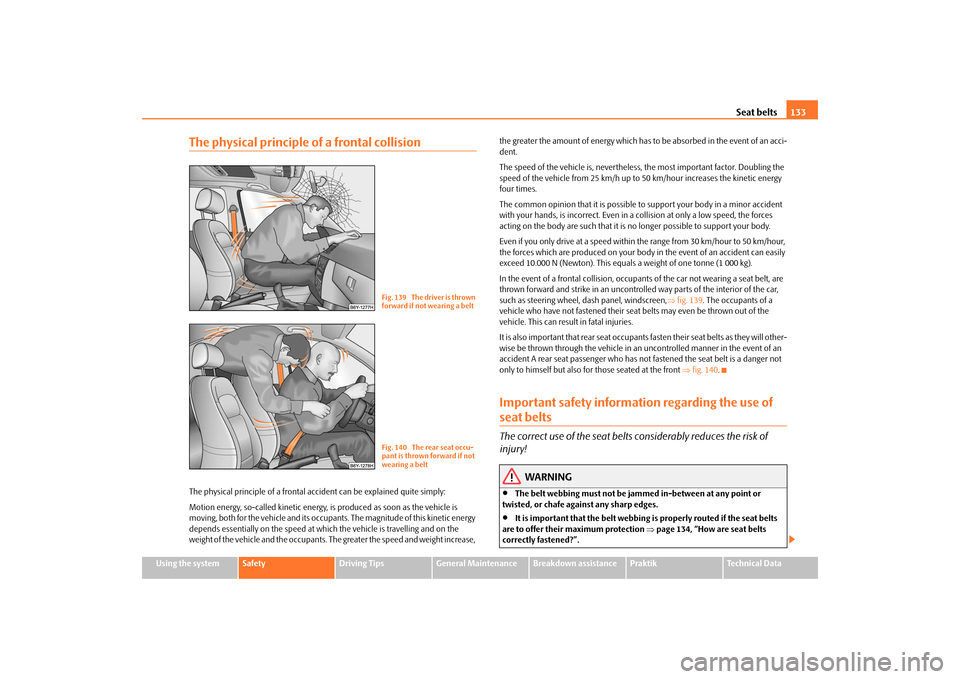
Seat belts133
Using the system
Safety
Driving Tips
General Maintenance
Breakdown assistance
Praktik
Technical Data
The physical principle of a frontal collisionThe physical principle of a frontal accident can be explained quite simply:
Motion energy, so-called kinetic energy, is produced as soon as the vehicle is
moving, both for the vehicle and its occupants. The magnitude of this kinetic energy
depends essentially on the speed at which the vehicle is travelling and on the
weight of the vehicle and the occupants. The greater the speed and weight increase, the greater the amount of energy which has to be absorbed in the event of an acci-
dent.
The speed of the vehicle is, nevertheless, the most important factor. Doubling the
speed of the vehicle from 25 km/h up to 50 km/hour increases the kinetic energy
four times.
The common opinion that it is possible to support your body in a minor accident
with your hands, is incorrect. Even in a collision at only a low speed, the forces
acting on the body are such that it is no longer possible to support your body.
Even if you only drive at a speed within the range from 30 km/hour to 50 km/hour,
the forces which are produced on your body in the event of an accident can easily
exceed 10.000 N (Newton). This equals a weight of one tonne (1 000 kg).
In the event of a frontal collision, occupants of the car not wearing a seat belt, are
thrown forward and strike in an uncontrolled way parts of the interior of the car,
such as steering wheel, dash panel, windscreen,⇒fig. 139. The occupants of a
vehicle who have not fastened their seat belts may even be thrown out of the
vehicle. This can result in fatal injuries.
It is also important that rear seat occupants fasten their seat belts as they will other-
wise be thrown through the vehicle in an uncontrolled manner in the event of an
accident A rear seat passenger who has not fastened the seat belt is a danger not
only to himself but also for those seated at the front ⇒fig. 140.
Important safety information regarding the use of seat beltsThe correct use of the seat belts considerably reduces the risk of
injury!
WARNING
•
The belt webbing must not be jammed in-between at any point or
twisted, or chafe against any sharp edges.
•
It is important that the belt webbing is properly routed if the seat belts
are to offer their maximum protection ⇒page 134, “How are seat belts
correctly fastened?”.
Fig. 139 The driver is thrown
forward if not wearing a beltFig. 140 The rear seat occu-
pant is thrown forward if not
wearing a belt
s29g.4.book Page 133 Wednesday, June 17, 2009 9:54 AM
Page 136 of 263
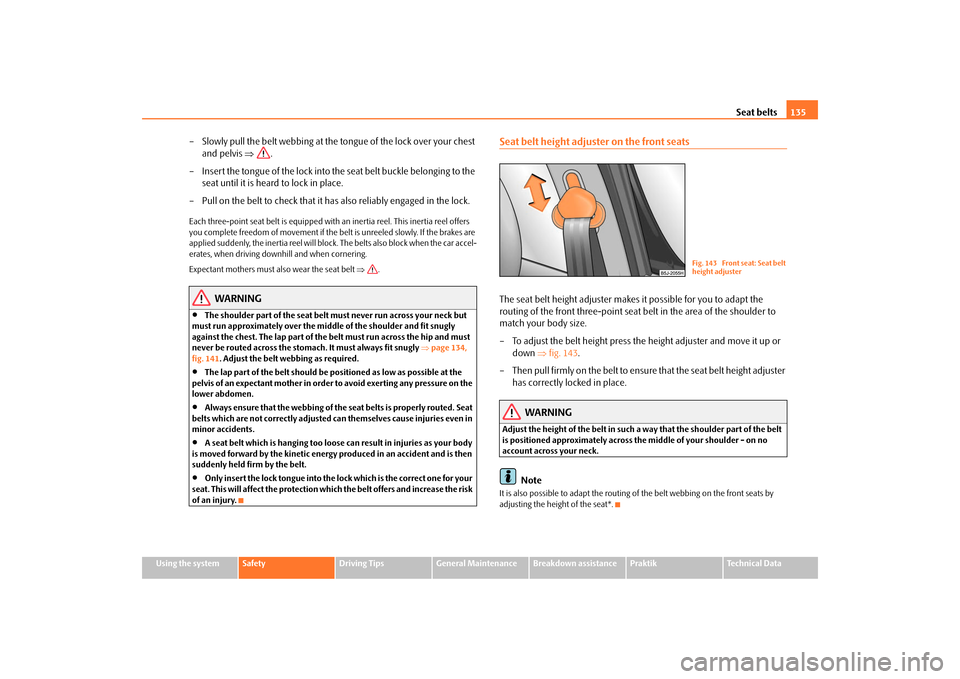
Seat belts135
Using the system
Safety
Driving Tips
General Maintenance
Breakdown assistance
Praktik
Technical Data
– Slowly pull the belt webbing at the tongue of the lock over your chest
and pelvis ⇒.
– Insert the tongue of the lock into the seat belt buckle belonging to the
seat until it is heard to lock in place.
– Pull on the belt to check that it has also reliably engaged in the lock.Each three-point seat belt is equipped with an inertia reel. This inertia reel offers
you complete freedom of movement if the belt is unreeled slowly. If the brakes are
applied suddenly, the inertia reel will block. The belts also block when the car accel-
erates, when driving downhill and when cornering.
Expectant mothers must also wear the seat belt ⇒.
WARNING
•
The shoulder part of the seat belt must never run across your neck but
must run approximately over the middle of the shoulder and fit snugly
against the chest. The lap part of the belt must run across the hip and must
never be routed across the stomach. It must always fit snugly ⇒page 134,
fig. 141. Adjust the belt webbing as required.
•
The lap part of the belt should be positioned as low as possible at the
pelvis of an expectant mother in order to avoid exerting any pressure on the
lower abdomen.
•
Always ensure that the webbing of the seat belts is properly routed. Seat
belts which are not correctly adjusted can themselves cause injuries even in
minor accidents.
•
A seat belt which is hanging too loose can result in injuries as your body
is moved forward by the kinetic energy produced in an accident and is then
suddenly held firm by the belt.
•
Only insert the lock tongue into the lock which is the correct one for your
seat. This will affect the protection which the belt offers and increase the risk
of an injury.
Seat belt height adjuster on the front seatsThe seat belt height adjuster makes it possible for you to adapt the
routing of the front three-point seat belt in the area of the shoulder to
match your body size.
– To adjust the belt height press the height adjuster and move it up or
down ⇒fig. 143.
– Then pull firmly on the belt to ensure that the seat belt height adjuster
has correctly locked in place.
WARNING
Adjust the height of the belt in such a way that the shoulder part of the belt
is positioned approximately across the middle of your shoulder - on no
account across your neck.
Note
It is also possible to adapt the routing of the belt webbing on the front seats by
adjusting the height of the seat*.
Fig. 143 Front seat: Seat belt
height adjuster
s29g.4.book Page 135 Wednesday, June 17, 2009 9:54 AM
Page 138 of 263
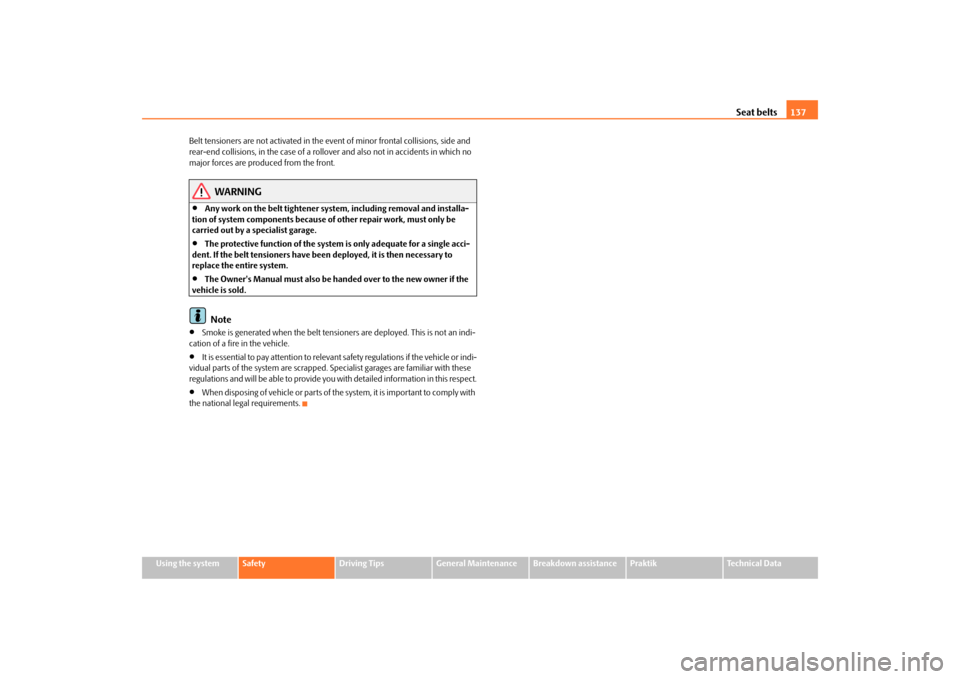
Seat belts137
Using the system
Safety
Driving Tips
General Maintenance
Breakdown assistance
Praktik
Technical Data Belt tensioners are not activated in the event of minor frontal collisions, side and
rear-end collisions, in the case of a rollover and also not in accidents in which no
major forces are produced from the front.
WARNING
•
Any work on the belt tightener system, including removal and installa-
tion of system components because of other repair work, must only be
carried out by a specialist garage.
•
The protective function of the system is only adequate for a single acci-
dent. If the belt tensioners have been deployed, it is then necessary to
replace the entire system.
•
The Owner's Manual must also be handed over to the new owner if the
vehicle is sold.Note
•
Smoke is generated when the belt tensioners are deployed. This is not an indi-
cation of a fire in the vehicle.
•
It is essential to pay attention to relevant safety regulations if the vehicle or indi-
vidual parts of the system are scrapped. Specialist garages are familiar with these
regulations and will be able to provide you with detailed information in this respect.
•
When disposing of vehicle or parts of the system, it is important to comply with
the national legal requirements.
s29g.4.book Page 137 Wednesday, June 17, 2009 9:54 AM